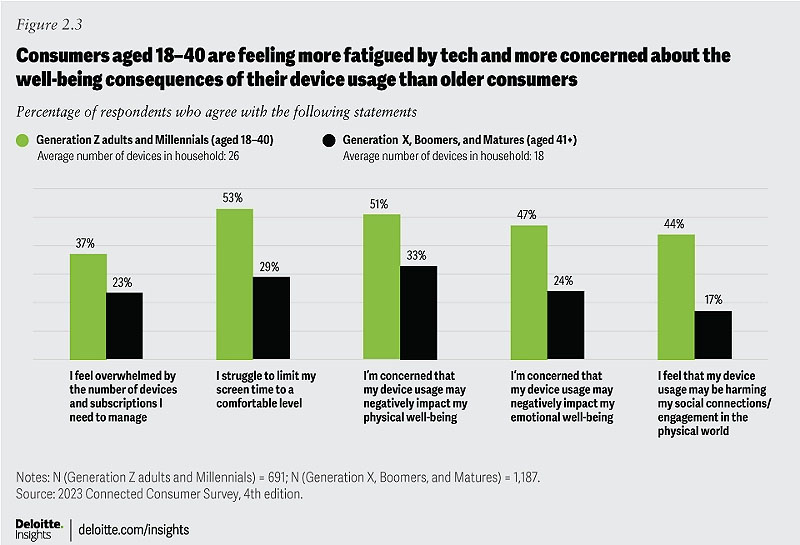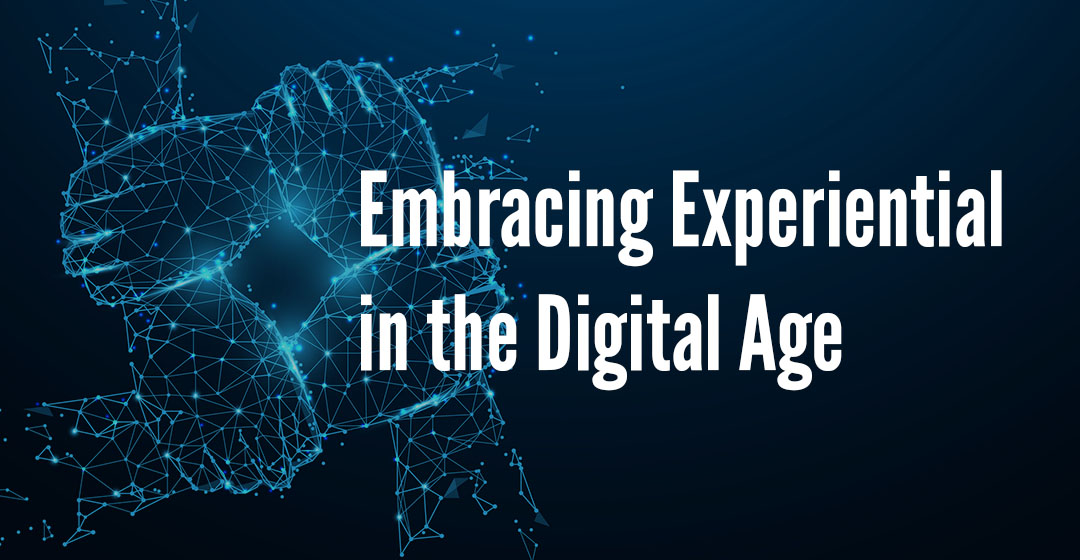Experiential marketing in the digital age may seem like a throwback in some ways, but nothing could be further from the truth. Experiential marketing is a perfect partner for digital media and can help drive business growth.
At this point, making observations about the speed of technological change in our lives seems redundant. ChatGPT launched in November 2023, and by January, it had 100 million users, making it the fastest-growing tool. As of March 2024, the tool has about 180 million users, and the website saw 1.6 billion visits in January. Over the last twenty years, the shift to a digital-centric world has enormously impacted the day-to-day lives of consumers and the tools marketers use to reach them.
With the dawn of the smartphone era, mobile access, and faster internet speeds, it’s easier than ever to get and stay online. Since 2018, Americans have spent more time with digital media than traditional media, and the gap continues to grow. But the digital revolution can be a double-edged sword.
As easy as communicating and sharing information can be, the sudden shift to a largely virtual life has left many wishing for stronger human connections. There are signs that Gen Z, while tech natives, may be shifting away from an “always on” life, with 32% preferring to meet with friends and family in person.
Brands have the opportunity to tap into this need with experiential marketing. These campaigns bring the brand into the physical world without cutting off the digital connection. This can form a stronger emotional connection with customers while standing out in a crowded digital space.
- Key elements of experiential marketing:
- Events that allow personal interaction with the brand, such as food trucks, 3D projections, and augmented reality experiences.
- Emotional and sensory experiences that create engagement and stronger memories.
- Opportunities for participants to generate user-generated content by sharing their experiences on social media.
The Basics of Experiential Marketing in the Digital Age
Experiential marketing brings a brand to life and allows consumers to interact with it in person. It can include almost any event or activation that the brand can dream up—from food trucks to 3D projections and augmented reality to wrapped surfboard walls or reproductions of Mount Rushmore.
Regardless of the format, these campaigns or events are distinct from traditional marketing in several ways. First, they offer a tangible way for audiences to connect with a brand while having an emotional and sensory experience. Handing out food samples can allow consumers to experience new flavors, the smell of coffee can draw people to your event, and a touching image projected four stories high can provoke an emotional reaction. These real-life experiences create engagement, build stronger memories, and help produce user-generated content as participants share their unique and exciting experiences on social media.

The Digital Age Dilemma
As brands produce more digital ads and content, these channels become more saturated. Add to that the surge in the use of generative AI, which makes it even easier to create images and content; we can expect that to balloon even further.
According to data from Comscore, over 5.3 trillion display ads were served to US consumers in 2022, a trillion more than in 2009. They also found that the average internet user sees more monthly. Standing out in this crowded field becomes nearly impossible. A Deloitte Global Marketing Trends report found that 56% of consumers actively avoided online ads in 2021, making it even more challenging to capture online attention.
With ads seemingly everywhere online, consumers are tired, overwhelmed, and losing trust. Digital fatigue is a growing concern, particularly among younger generations.
- The Digital Age Dilemma:
- Increased digital ad production leading to saturation.
- High rates of online ad avoidance with 56% of consumers actively avoiding online ads.
- Growing digital fatigue among consumers, especially younger generations.

The Human Connection Factor
To break through this digital ad fatigue, brands should tap into consumers’ desire for authentic and meaningful human interactions. Experiential marketing can connect to human emotions and create memorable and shareable experiences. This creates a genuine connection that can build brand loyalty. According to research performed by the Harvard Business Review, customers who feel emotionally engaged with a brand are more likely to make repeat purchases and promote the brand to others.
One key element of successful experiential marketing in the digital age is finding the elements of your brand that consumers will connect with and that you can bring to life in the physical world. That requires understanding who they are, what they do and like, and, significantly, where they go. It’s essential to build the experience around the consumer and give them something of value. Whether it’s free samples or coupons, free trials, contest entries, fun pictures, or even great memories. Make it fun, make it surprising, make it unique, but most of all, make it personal.
- Benefits of Experiential Marketing:
- Creates a genuine connection that builds brand loyalty.
- Enhances brand recognition and recall, with 74% of customers forming a better opinion of a brand after an event.
- Facilitates valuable, real-world feedback and direct consumer engagement.

The Benefits of Experiential Marketing in the Digital Age
Traditional marketing campaigns, whether classic billboard ads or modern short-form videos, act as a one-way monologue from the company to the consumer. These media can deliver effective messaging, target the right audience, and drive consumers through the funnel from top to bottom. They rightly have an important place in any media plan. However, they are ultimately one-directional.
Experiential activations allow consumers to dialogue with the brand, increasing brand recognition and recall. The Event Marketing Institute found that 74% of customers had a better opinion of a brand after participating in an experiential marketing event. Hosting these events also accelerates social media sharing and word-of-mouth promotion, with 98% of attendees creating social or other content at these events, according to an EventTrack report.
There are also very practical benefits of experiential marketing in the digital age. They can provide valuable, real-world feedback about a new product. They can allow for demonstrations or “test drives,” with brand ambassadors able to explain the features and benefits in more detail and answer questions. They enable brands to get consumers to sign up for their service’s mailing lists or trial periods. They can bring consumers into the brand’s digital ecosystem. And, if brands plan correctly, they can provide a host of material for social media and other channels.
The Integration of Digital and Experiential
But make no mistake—we’re not Luddites. While we extol the virtues of experiential activations, it doesn’t mean we’re slagging digital. It’s not either/or. It’s “both=more.” Adopting experiential marketing doesn’t mean turning away from digital. In fact, the two approaches complement and even enhance each other.
Digital media can be used before an experience by broadcasting to a local audience about the event. Share times and locations in teaser campaigns to build interest. Use clues or scavenger hunts in advance to unlock special benefits, experiences, or prizes.
Digital technology can also make events more exciting and engaging in many ways. Projection mapping can transform the event space, and touch screens make it easy for participants to sign up for future communication or explore products. Real-time social feeds or chat boards allow participants to engage in in-person and on-device interactions. Mobile gamification can engage the audience on multiple levels.
Experiential activations are also great sources of digital content, both brand-created and user-generated. Sharing events on social media can help drive brand awareness, interest, and participation in future events.
- Integration of Digital and Experiential Marketing:
- Use of digital media to promote and enhance physical events.
- Adoption of technologies like projection mapping and touch screens at events.
- Ability to collect valuable data and analytics to measure event success and plan future campaigns.

The Future of Experiential Marketing
As experiential marketing grows in popularity, marketers can expect it to develop new capabilities. For one, experiential campaigns will focus more on data and analytics. Collecting information like the number of registrations, traffic to the event’s landing page, the number of people who attend the event, and the number of social media posts during and after the event can provide an accurate measurement of success and helpful guidance for future events.
It’s also important for marketers to pay attention to sustainability, inclusivity, and social responsibility. Sometimes, events can produce significant waste, which can be off-putting to the 78% of consumers who say a sustainable lifestyle is important to them. Brands should take advantage of reusable, recycled, and recyclable alternatives to disposable event supplies and should make it a point to share that information. Socially conscious consumers will also appreciate events that are inclusive and accessible.
Experiential activations can also help drive direct commerce and can become more important as a revenue source. Making products or services available to purchase during the event or experience will take full advantage of the audience’s engagement and the time they spend with the brand.
- The Future of Experiential Marketing:
- Focus on sustainability, inclusivity, and social responsibility in event planning.
- Potential for experiential campaigns to drive direct commerce.
Embrace Experiential Marketing
We are fully entrenched in the digital age, but marketers must still engage with customers in person. Experiential marketing events create a sense of human connection, allow guests to have emotional experiences that build brand loyalty, and increase engagement on social media channels.
These campaigns blend seamlessly into existing digital marketing efforts and don’t require a complete overhaul of your brand’s existing strategy—they simply enhance and extend your marketing footprint in the real world.
Planning an experiential activation can be intimidating, but it doesn’t have to be. We put together a guide to help you through some of the initial stages and understand some of the fundamentals before you take those first steps.





